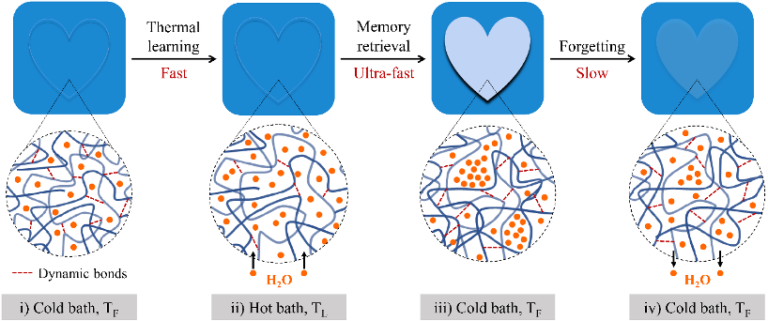The memory of our brain, stored in soft matter, is dynamic, and it forgets spontaneously to filter unimportant information. By contrast, the existing manmade memory, made from hard materials, is static, and it does not forget without external stimuli. Therefore, recreating this dynamic memory in manmade materials is challenging. To address this problem, our laboratory succeeded to report a hydrogel containing abundant dynamic bonds (e.g., ionic bonds, and hydrogen bonds) can mimic the dynamic memory function of the brain: Encoded information fades with time depending on the memory intensity[1].
1. Thermal learning
In this study, we placed a thin hydrogel between two plastic plates; the top plate had a hollowed-out shape or letter, leaving only that area of the hydrogel exposed. For example, patterns included an airplane, and a word “GEL.” We initially placed the gel in a cold bath to establish equilibrium. Then we moved the gel to a hot bath. The gel absorbed water into its structure causing a swelling, but only in the exposed area. This process imprinted the pattern, which is like a piece of information, onto the gel. When the gel was moved back to the cold bath, the exposed area turned opaque, making the encoded (or learned) information visible.


2. Spontaneous forgetting
At the cold bath, the exposed area of this hydrogel gradually shrank, releasing the water that it had absorbed. The pattern slowly faded, showing a spontaneous and dynamic forgetting process of learned information. The longer the gel was soaked in the hot bath, the darker or more intense the imprint, and therefore the longer the gel took to fade or “forget” the information. Moreover, we also showed hotter temperatures intensified the memories. This behavior is similar to the memory in humans: The longer you spend learning something or the stronger the emotional stimuli, the longer we take to forget it.

3. Sequential forgetting
More interestingly, the forgetting process can be programmed by tuning the thermal learning time or temperature. For example, when they applied different learning times to each letter of “GEL” (26, 18, and 12 min for “G,” “E,” and “L,” respectively), the letters disappeared sequentially.

References
- Chengtao Yu, Honglei Guo, Kunpeng Cui*, Xueyu Li, Ya Nan Ye, Takayuki Kurokawa, Jian Ping Gong*. Hydrogels as dynamic memory with forgetting ability. Proceeding of the National Academy of Science of the United States of America 2020, 117, 18962-18968.

